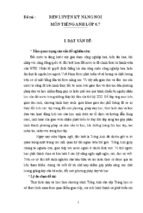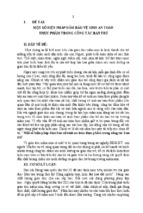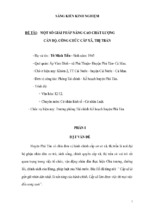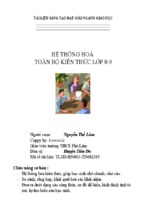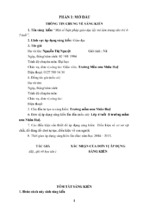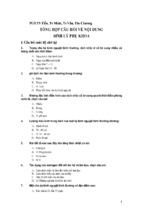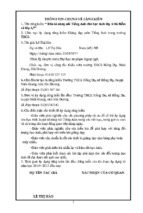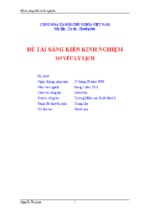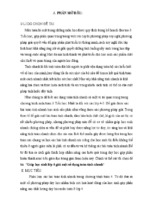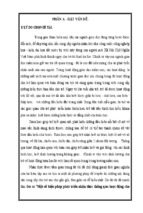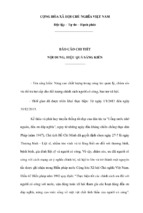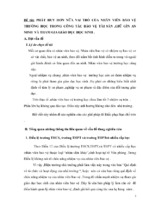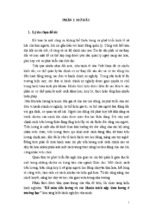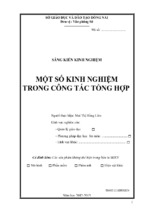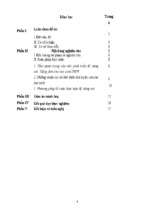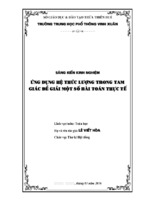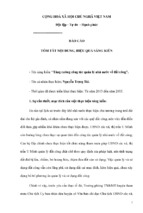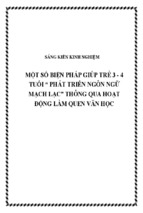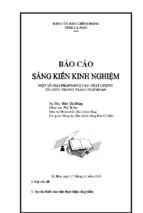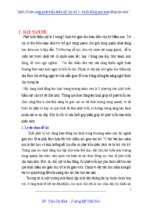SỞ GIÁO DỤC VÀ ĐÀO TẠO HÀ NỘI
SÁNG KIẾN KINH NGHIỆM
TÊN ĐỀ TÀI
PHÁT HUY HIỆU QUẢ HOẠT ĐỘNG CẶP, NHÓM
TRONG QUÁ TRÌNH DẠY HỌC TIẾNG ANH Ở TRƯỜNG THPT
Lĩnh vực/ Môn: Tiếng Anh
Cấp học : THPT
Tác giả: Nguyễn Thị Tuyết
Đơn vị công tác: Trường THPT Lưu Hoàng - Ứng Hòa – Hà Nội
Chức vụ: Giáo viên
Năm học 2018- 2019
Nguyễn Thị Tuyết – Trường THPT Lưu Hoàng - Ứng Hòa - Hà Nội
A - INTRODUCTION
I. REASONS FOR CHOOSING THE RESEARCH
During the years, we are carrying out the reformation in teaching new
English textbooks. Most of the teachers are used to these new Englishs and try
to find out good teaching methods as much as possible to apply in English
periods.
In order to make his English period more effective, the teacher himself
must find out the way of teaching suitable for his students. I think that in a good
English period, the students play active roles and the teacher is only the adviser.
All the teachers know pair work and group work are the main
activities in teaching English at schools. There is always pair work or
group work in each lesson of textbook but at times it is not suitable for some
classes. If the teacher wants his students to play active roles, he should design
pair work and group work before going to class for each period. But sometimes
the teacher gets stuck in organizing pair work and group work effectively.
I myself want to present how I apply pair work and group work in most of
my teaching English periods.
II. AIMS OF THE RESEARCH
With the reasons above in my mind, the specific aims of the study accordingly
are:
- To introduce pair work and group work and to show the advantages of
working in pairs and groups.
- To show how to organize pair and group work effectively and how to
deal with initial problems that may arise.
- To show how pair and group work can be used for various classroom
activities.
- To give teachers confidence in using pair and group work themselves.
III. SCOPE, OBJECT AND RESEARCHING METHOD
- Scope: Researching in the process of teaching English at Luu Hoang
high school.
- Object: This subject is concerned with ways of organizing activities in
the class.
- Researching method: Reading reference books, discussing with other
teachers, applying in teaching, observing and drawing out experiences.
1/16
Nguyễn Thị Tuyết – Trường THPT Lưu Hoàng - Ứng Hòa - Hà Nội
B - CONTENT
I. GENERAL INTRODUCTION
1. What are pair work and group work?
1.1. Pair work:
The teacher devices the whole class into pairs. Every student works with
his or her parner and all the pairs work at the same time. The teacher walks
around, listens and intervenes little if necessary.
1.2 Group work:
Students work in small groups (of four or five) on tasks that entail
interaction: conveying information, for example, or group decision making. All
the groups work at the same time. The teacher walks around listening, intervenes
little if at all
2. Advantages and disadvantages of pairwork and groupwork
2.1. Advantages
- To increase the amount of student practice: When students work in pairs or
groups they have more chance to practise. By working in pairs or groups
students often feel more willing to talk among themselves in a small group
rather than with a teacher in a large group so that it dramatically increases the
amount of talking for individual students.
- To increase learners’ confidence: The students feel much more comfortable to
speak foreign language with one or two other students rather than with the
whole class and the teacher. Especially shy students or ones who are not good at
speaking language yet feel more relaxed and self-confident trying to put their
language abilities to a test during the activity and seeing how to use them. This
encourages students to cooperarte with one another.
- To motivate students’ fluency: While working in pairs or group abilities,
students can use the language freely and express their opinions and thoughts
without any restrictions. It is difficult not to get the impression that fluency can
be improved only during constant speaking practice in the atmosphere of
independence and in the state of relaxation.
- To increase students’ motivation: While working in pairs or groups, the
activities are available. As we know, a huge variety of activities influences the
course of a lesson and its success. The more different activities the teacher use
in the lesson, the bigger their motivtion is. In fact, students’ motivation
increasesbecause they are active and feel important during these activities. In
keeping with this, the teacher is going to experiencesuccess in his/her work
because motivated students are usually good languages learners and they always
make progress.
2.2. Disadvantages
- To speak native language: One of the disadvantages is that students often
speak in their native language. If the class is really big with too many students, it
is very difficult for the teacher to listen to all pairs or groups at the same time.
2/16
Nguyễn Thị Tuyết – Trường THPT Lưu Hoàng - Ứng Hòa - Hà Nội
However, the teacher can still do something to change situation. The teacher
should estabilish certain rules at the beginning of the school year and be very
strict about them.After sometime the good habit of speaking only English may
be established.
- To make mistakes: An other problem is incorrectness. While students work in
pairs and groups, the teacher usually do not disturb them, even if he/she notices
some mistakes they have made, but we should not forget that errors or mistakes
are an indissoluble element of the process of learning. Besides, students try to
correct each other rather than learn the mistakes. One of the main points of
having learners speak to each other is to help them increase their confidence and
reduce the anxiety that is often found in a purely teacher-centered classroom.
Pairwork and groupwork activities are usually geared to fluency enhancement
rather than accuracy practice.
- To eliminate shy and weak students from the practice: Some shy and weak
students can be eliminated from the practice, because of individuals who always
tend to dominate. It is not a problem when they work in pairs, but as far as the
groups are concerned, the teacher should assign roles to avoid one or two
learners taking over the activity and others becoming passive observers.
- To make noise and indiscipline: Working in pairs and groups in a large class
makes noise and indiscline, the teacher have more troublesome than the learners
have. Participants in a pairwork or groupwork activity are normally unware of
the noise and of what other pairs or groups are doing. The only possible here
could be solved if the classroom had particularly thin walls
II. ORGANIZING PAIR WORK AND GROUP WORK
1. Group and pair work organization
- The success of group or pair work depends on some extents:
The surrounding social climate.
How habituated the class is to using it
The selection of an interesting and stimulating task whose performance is
well within the ability of the group or pair.
- More immediately, it also depends on:
Effective and careful organization.
2. Organization steps:
2.1. Presentation:
The instructions that are given at the beginning are crucial. If the students
do not understand exactly what they have to do, there will be time-wasting,
confusion, lack of effective practice, possible loss of control. Select tasks that
are simple enough to describe easily; and in monolingual classes, you may find
it cost-effective to explain some or all in the students’mother tongue. It is
advisable to give the instructions before giving out materials of dividing the
class into groups; and a preliminary rehearsal or ‘dry run’ of a sample of the
3/16
Nguyễn Thị Tuyết – Trường THPT Lưu Hoàng - Ứng Hòa - Hà Nội
activity with the full class can help to clarify things. If your students have
already done similar activities, you will be able to shorten the process, giving
only brief guidelines; It is mainly the first time of doing something with a class
that such care needs to be invested in instructing.
Try to foresee what language will be needed, and have a preliminary
quick review of appropriate grammar or vocabulary. Finally before giving the
sign to start tell the class what the arrangements are for stopping: If there is a
time limit, or a set signal for stopping, say what it is; if the groups simply stop
when they have finished, then tell them what they will have to do next. It is wise
to have a reserve task planned to occupy members of groups who finish earlier
than expected.
2.2. Process:
Teacher goes from group to group, pair to pair, monitor, and either
contribute or keep out of the way whichever is likely to be more helpful. If you
do decide to intervene, your contribution may take the form of:
- Providing general approval and support;
- Helping students who are having difficultly;
- Keeping the students using the target language (in many cases your mere
presence will ensure this!)
- Tactfully regulating participation in a discussion where you find some
students are over dominant and others silent.
2.3. Ending:
Draw the activity to a close at a certain point. Try to finish the activity
while the students are still enjoying it and interested, or only just beginning to
flag.
2.4. Feedback:
A feedback session usually takes place in the context of full-class
interaction after the end of the group work. Feedback on the tasks may take
many forms:
- Giving the right solution, if there is one.
- Listening to and evaluating suggestions.
- Pooling ideas on the board.
- Displaying the materials the groups/ pairs have produced.
And so on.
The main objective here is to express appreciation of the effort that has
been invested and its results. Feedback on language may be integrated into this
discussion of the task, or provide the focus of a separate class session later.
3. Demonstration:
3.1. Example of pair work:
Example 1:
4/16
Nguyễn Thị Tuyết – Trường THPT Lưu Hoàng - Ứng Hòa - Hà Nội
A teacher has an intermediate class. She presented “like/don’t like” and
then she uses this exercise for free practice in pairs :( Unit 1- Speaking. English
10)
Exercise 3: Likes and dislikes
Pairwork : Ask what your friend likes and dislikes
Find out which chores he/she likes or dislikes the most
- Things the teacher did before, during and after the activity.
Before: Teacher says “All right. Exercise3. Work in pairs; ask and answer
the questions”
During: Teacher sits at one place and says nothing.
After: Teacher says “Everyone finished? Good. Now look at exercise
4 ….”
- Some question for us:
Do you think the activity was successful?
What do you think might have gone wrong?
What could she do to make it more successful?
*Discuss why the activity was not successful, and what the teacher could do to
make it more successful:
- She could prepape for the pairwork by establishing what the questions
and answers should be. She could also demonstrate the pairwork by asking
questions round the class, or by getting one pair of students to ask and answer in
front of the class. Then students would know exactly what to do.
- She could be more active in starting the pairwork. Instead of just saying
‘work in pairs’, she could show students who to work with, check that everyone
had started working in pairs. This would be very important if the class were not
used to pairwork.
- During the activity, she could move quickly round the class to check that
students were talking and to see when they finished.
- Instead of waiting for everyone finished, she could stop the activity.
Then there would be no chance for students to get bored and start talking about
other things.
- After the pairwork, she could ask some pairs what they said, or ask a
few pairs to repeat their conversation in front of the class.
Example 2:
Teacher presented “used to /didn’t use to + inf (Unit 4, part E – language
focus) and then used the following exercise for free practice in pairs.
Exercise: Work in pairs, ask what your friends used to do and didn’t use
to do (Ask about food, sport, music, school, subject ……. ).
A possible procedure:
* Introduce the exercises and show what questions and answers students
can give:
5/16
Nguyễn Thị Tuyết – Trường THPT Lưu Hoàng - Ứng Hòa - Hà Nội
Teacher: Now you are going to talk about things you used to do and things you
didn’t use to do. Look at the exercise. What question can you ask?
What about food?
Student A: What food did you use to eat when you were small?
Student B: I used to eat ice – cream.
(And so on)
*Write the basic question on the board:
What (food) did you use to eat?
*Ask a few questions round the class to show the kind of conversation
students might have:
Teacher: What kind of music did you use to listen, Huong?
Student: I used to listen to pop music.
Teacher: Pop music? When did you use to listen to it?
(And so on)
If teacher likes, ask two students to have similar conversations, while the
others listen.
* Divide the class into pairs:
Teacher: Now. You’re going to work in pairs (Indicate by pointing. If there are
single students left without a partner, make groups of three). Ready? Ask and
answer the questions. First, one person asks all the questions then change round.
Start now.
* Students work in pair. Teacher moves quickly round the class, checking
that everyone is talking (but do not try to correct mistakes, as this will
interrupt the activity)
* When most pairs have finished, stop the activity. Ask a few students what
their partners said:
Teacher: Now, stop talking. Mai, tell me about Huong. What did she used to do?
Student: She says she used to eat ice cream, listen to pop music and swim in the
afternoon, she liked meat but she didn’t use to eat it. She was afraid of being
overweight
* Give feedback
- Well done.
- Pay attention to….
(And so on)
3.2. Example of group work.
Task 3 (Unit 3 – Speaking - English 10)
This is a free activity and aims to develop fluency in speaking. The procedure
may be:
Divide students into groups of four or five.
Read through the instrutions and make sure that each group understands
what to do. Choose one “secretary” in each group to write the list but emphasis
that everyone in the groups should agree on what to write.
6/16
Nguyễn Thị Tuyết – Trường THPT Lưu Hoàng - Ứng Hòa - Hà Nội
While the activity is going on, move from groups, but do not interrupt
more than is necessary.
When some groups have finished their discussion, stop the activity, ask
one person from each group to report on what they decided
Give feedback: - Content
- Popular mistakes
3.3. Example of dividing the class:
First, draw a plan of your own class of 50 students. Show how you would
divide the class for a pair work or a group work activity and what instructions
you would give:
Here are two rows of a class of 50 students. The desks are fixed and the
students sit on chairs.
1
2
4
3
5
6
7
8
10
11
9
12
13
For pair work: Most students could work with the person next to them.
Student 6 could turn round and work with student 3 and students 7, 8, and 9
work as three together. Or student 3 could move to work with student 4 and the
second row could be divided into two pairs and one three.
For group work: Students could work in threes and fours along each row.
This would be easy to organize but would make it difficult for students to work
well as a group, as they would be in a straight line. Or Students in the first row
could turn round and form groups with those behind.
The first few times that you try pair or group work, you need to give
careful instructions and know exactly how you will divide the class. Pair work
and group work can become a routine. Once students are used to it and have
regular working partners, it can be organized quickly and easily.
4. Suggestions for some popular kinds of practice
Pairwork and groupwork are not “teaching methods”, but ways of
organizing the class. They can be used for many different kinds of activity, and
are naturally more suitable for some activities than for others. Before deciding
what kind of activity will be used teacher should answer the following questions:
- Could you use pairwork or groupwork for part of the activity?
- If so, exactly what would students do in pairs or groups?
- What would you need to do before the pair /group stage?
7/16
Nguyễn Thị Tuyết – Trường THPT Lưu Hoàng - Ứng Hòa - Hà Nội
- Is there anything you would do after it?
- Is there anything you would do after it?
Here are suggestions for some popular kinds of practice:
*Pattern practice:
This can be done in pairs in the same way as practicing structure with
“used to” mentioned in part 2 - Demonstration. Any controlled oral practice can
be done first with the whole class, and then in pairs.
* Practising short dialogues:
Acting out short dialogues can very easily be done in pairs, with little
chance of making mistakes. It can be done first with pairs of students in front of
the class and then with all students working in pairs at the same time.
* Reading a text and answering questions:
Students can disscuss questions in pairs or groups and then read the text
or they can read the text silently and then ask and answer questions in pairs or
groups. This is a good way of involving the whole class in answering questions.
* Short-writing exercises:
Student can sit in groups and decide together what to write. One student
acts as “secretary”. This can be difficult to organise but in a large class it has the
advantages that students correct each others’mistakes and the teacher only has a
few papers to mark at the end.
Pair work can be used for correcting written work (eg: homework)students sit in pairs and correct what their partner has written.
* Discussions:
With more advanced class, discussions can be conducted in group. It is
important to define the discussion clearly and to ask each group to report their
conclusions afterwards.
* Grammar exercises:
Student can do grammar exercises orally in pairs; the teacher goes
throught the answers afterwards with the whole class and students write the
exercises for homework. This is more interesting and productive than students
doing exercises alone, in silence.
III. APPLYING THE RESEARCH IN TEACHING
Unit 5: Inventions
Lesson 3: Speaking- Unique inventions
Teacher: Nguyen Thi Tuyet - Class: 10A5
I. Aims and Objectives:
- To teach Ss to talk about inventions, their uses and their benefits.
- To teach Ss some words and phrases related to inventions.
- By the end of the lesson, students will be able to:
+ Talk about unique inventions, their uses and their benefits.
+ Perform their viewpoints to other people in real life.
8/16
Nguyễn Thị Tuyết – Trường THPT Lưu Hoàng - Ứng Hòa - Hà Nội
II. Preparations:
- Teacher: + Handouts, textbook and pieces of papers.
+ Language: Present simple, gerunds after ‘used for’ and
infinitive to express purposes.
- Students: Textbook
III. Methods: - The whole lesson: Integrated, mainly communicative.
- Anticipated problems: Students may face with vocabularies relate
to these devices
IV. Procedures:
Time/
Activities
Interaction
Stages
s
1. Warm
up
5
minutes
- Check the class’ attendance
-Ask Ss to watch a video about Modern inventions
and their functions in two minutes.
-Work in 4 groups to write as many devices as
possible
- Four groups will have an exchange and check, the
representatives from four groups present their works
in the boards. Group 1 exchanges Group 2, Group 3
exchanges Groups 4
- Check Ss’ work and give comment.
Suggested answers
1. A Washing machine
2. A vacuum cleaner
3. A blender
4. A digital camera
5. A digital audio player
6. A radio
7. A printer
8. A 3D – printer
9. A cell phone
10. An air – conditioner
- Lead in the new lesson.
2. New
lesson
Unit 5: Inventions
Lesson 3: Speaking- Unique inventions
8
minutes
Task 1: Practise the conversation with a partner
- Ask Ss to think of the heading of the speaking
lesson “ Unique inventions” → very special and
unusual inventions.
9/16
T <--> Ss
Group
work
Pair work
Nguyễn Thị Tuyết – Trường THPT Lưu Hoàng - Ứng Hòa - Hà Nội
- Teacher models the conversation first, Sts repeat
Whole
in chorus
class
- Ask Ss to practise the conversation in pairs.
- Invite two pairs to read aloud, give comment on
Ss’ pronunciation.
T <--> Ss
- Explain some new words
+Solid object (NP):
+ Original (n)
Notice: Yes or No questions always have rising
intonation at the end of the sentences, whereas, Wh- Pair work
questions often have falling intonaton at the end of
the sentences
Take note
1. Do you live here?
name?
5
minutes
8
minutes
2. What is your
Task 2: Complete the table with the informaton T <--> Ss
about the inventon mentioned in the conversaton
above
-Have Ss complete the table about 3- D printer.
- Control and assist.
- Check Ss’ work and comment.
- Work in pairs to fill in the suitable information in
the table.
* Suggested answers.
a. Name of
3-D printer
Group
invention
work
b. Characteristics
bigger and heavier than a normal
printer
c. Use
To produce solid objects similar
to the originals
d. Benefits
Saving a lot of money
Task 3: Discuss two more inventions with a
partner. Complete the table to below with a
phrase in the box
- Ask Ss to look at the pictures of a portable solar
charger and a USB stick, and discuss which benefits
( in the box) are suitable for each invention.
- Explain new words if any.
- Let Ss work in groups to do this activity in 4
minutes.
10/16
Ss <--> Ss
Pair work
Nguyễn Thị Tuyết – Trường THPT Lưu Hoàng - Ứng Hòa - Hà Nội
- Check some Ss’ answers. And comment.
- Work in groups of three or four to discuss the
benefit of a portable solar charger and a USB stick.
* Suggested answer:
+ Portable solar charger: not dependent on
electricity, environmentally- friendly, easy to carry,
not costly
+ USB stick: not costly, easy to use, easy to
transport files.
Practise speaking the conversation
6
minutes
10
minutes
Pair work
T <--> Ss
Task 4: Work with a partner. Choose one
invention mentioned in 3 and make a similar Pair work
convention as in 1. You can use the information
in the table os your own ideas
- Have Ss in pairs make up similar dialogues with
Role- play
the information in the table.
- Use real object: USB stick, ask Ss questions
Model conversation
Hoa: What is that device, Lan?
Lan: It is USB stick
Hoa: Is looks small, Is it easy to use, to carry?
Lan: Yes, of couse, it is also environmentallyfriendly, portable and cheap
Hoa: Really? What can we do with this device?
Lan: It is very useful, you can transport files easiy,
store data
Hoa: Thank you so much, Lan
- Check two to three pairs and give comment on Ss’
pronunciation and intonation.
Task 5: Work in groups. Choose one of the
inventions below and prepare to talk to
introduce it to other group member
- T gives a model for Ss.
I’d like to recommend a ……………to all of you.
This machine is small and portable. It is used
to …….. within a short time. It’s an economical
device for ………..
Full suggested conversation
I’d like to recommend a food processor to all of
you. This machine is small and portable. It is used
to prepare meals with delicious dishes within a short
11/16
Group
work
Other
groups
comment
Nguyễn Thị Tuyết – Trường THPT Lưu Hoàng - Ứng Hòa - Hà Nội
time. It’s an economical device for all households.
- Get Ss to work in groups of four or five to give a
similar small talk.
- Check some Ss and give feedback to their talks.
+ Free talking with some modern devices such as: a
cell phone, a radio, a televition, an air
conditioner, …..
+ Free speaking about uses of some real objects:
pen, book, ruler, watch, hat, glasses,….
3.
Consolid
-ation
2
minutes
4.
Homewo
-rk
1 minute
- Summarize what they have learnt by asking Ss
some questions
- Ask students to learn by heart the expressions.
- Prepare for the next lesson.
- Prepare a small talk to introduce a new item to the
class in the next period.
12/16
Pair work
T <--> Ss
T <--> Ss
Nguyễn Thị Tuyết – Trường THPT Lưu Hoàng - Ứng Hòa - Hà Nội
C – CONCLUSION
I. RESULT AFTER APPLYING THE RESEARCH IN TEACHING
By organizing pair work and group work, students in my class
become more confident in English class. Once I give a task and ask them to
work in pairs or groups they can understand and do it successfully. During the
practice, students can help each other to correct their mistakes in pronunciation,
intonation or grammar. After a year applying pair work and group work
activities in teaching English at Luu Hoang high school, I have got some
satisfactory results. Most of my students have become more interested in
learning English and of course their ability to use English in communication has
been improved step by step. In each lesson, students are more active, more
flexible and enthusiastic participation in the speaking lessons.
That is the main reason of the following results from the test of
speaking carried out during the recent school year at my school in comparison
with those before being applied as follows:
Table 1:
Before applying
Class
Total
The number of students scoring proficient
Percentage
The number of students scoring pretty
Percentage
The number of students scoring average
Percentage
The number of students scoring below
average
Percentage
Table 2:
10A5
11A5
( 43
(27
students) students)
0
1
0%
5
11,6 %
17
39,5 %
21
3,7 %
4
10,8 %
7
26 %
15
48,9 %
59,5 %
After applying
Class
Total
The number of students scoring proficient
10A5
11A5
( 43
(27
students) students)
6
5
Percentage
The number of students scoring pretty
Percentage
The number of students scoring average
13,9 %
15
34,8 %
12
13/16
18,5 %
10
37 %
7
Nguyễn Thị Tuyết – Trường THPT Lưu Hoàng - Ứng Hòa - Hà Nội
Percentage
The number of students scoring below
average
Percentage
27,9 %
10
26 %
5
23,4 %
18,5 %
Comparing the results obtained from the two tables above, I can see the
progress of the students when speaking English through pair work and group
work activities with these methods. As can be seen in the Table 1, the
percentage of students getting bad marks in the speaking test accounts for more
than 50% and the rate of students scoring good or excellent makes up for below
15%. From the second table, after the adoption of measures to organize pair
work and group work in teaching speaking skill, the percentage of students
scoring at or above average has increased significantly (from about 50% in
Table 1 to about 80% in Table 2).
II. CONCLUSION:
In group or pair work, learners from a learning task through small group
interaction. Learners in a class that is divided into six groups or 15 pairs get six
times or fifteen times as many opportunities to talk as in full class organization.
They also have other advantages: They foster learner responsibility and
independence, can improve motivation and contribute to a feeling of cooperation
and warmth on the class, so that organizing pair work and group work
effectively helps improves learning outcomes.
III. PETITION
For this method to be more effective, I would like to propose:
School: good material facility, full intuitive utensils and vivid pictures
Teachers: careful lesson plans, suitable handouts
Students: preparing new lesson carefully
Through the lecture prosess, I have reseached and studied from my
collegues and friends. I have understood this skill better and discovered many
useful things about organizing pair and group disussions in English lesson.
However, there are many limitations in the process of research and
implementation. I would like to receive contributions for perfection
XÁC NHẬN CỦA
THỦ TRƯỞNG ĐƠN VỊ
Hà Nội, Ngày 27 tháng 2 năm 2019
Tôi xin cam đoan đấy là SKKN
của mình viết, không sao chép nội dung
của người khác
Tác giả
Nguyễn Thị Tuyết
14/16
Nguyễn Thị Tuyết – Trường THPT Lưu Hoàng - Ứng Hòa - Hà Nội
STT
1
2
3
CONTENTS
A - INTRODUCTION
I. Reasons for choosing the research
II. Aims of the research
III. Scope, object and researching method
B - MAIN CONTENT
I. General introduction
1. What are pair work and group work?
2. Main advantages, problems and solutions to the problems.
II. Organizing pair work and group work
1. Group and pair work organization.
2. Organization steps
3. Demonstration.
4. Suggestions for some popular kinds of practice
III. Applying the research in teaching
C - CONCLUSION
I. Result after applying the research in teaching
II. Conclusion
15/16
PAGE
1
1
1
2
2
2
3
3
3
4
7
8
13
14
Nguyễn Thị Tuyết – Trường THPT Lưu Hoàng - Ứng Hòa - Hà Nội
REFERENCE BOOKS
1. Practical handbook of language teaching (David Cross)
2. A course in language teaching - Practical and Theory (Penny Ur)
Cambrige university press
3. Giao trinh giao hoc phap (Tổ ngoại ngữ –Khoa ngôn ngữ và văn hóa Anh Mĩ - Úc – Trường đại học quốc gia Hà Nội)
4. Phương pháp dạy tiếng Anh Trung học phổ thông (Nguyễn Hạnh Dung)
16/16
- Xem thêm -

